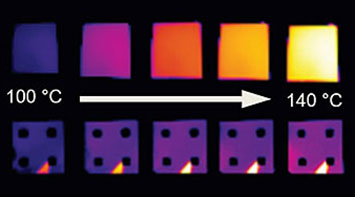Quantum Materials Cloak Thermal Radiation
February 24, 2020

Thermal images of samples on a heated stage. The top row shows the reference sample gradually heating as the temperature increases. The bottom row shows the apparent temperature of the sample is masked by ultrathin films of samarium nickel oxide as the stage heats from 100 °C to 140 °C.
What is the scientific achievement?
A collaborative team of users, led by University of Wisconsin-Madison, worked closely with CFN staff to show that ultrathin films of samarium nickel oxide can mask the thermal radiation emitted from sources. The cloaking mechanism is due to this quantum material undergoing a unique, gradual insulator-to-metal phase transition across the temperature range of 100 °C and 140 °C — the temperature range of interest.
Why does this achievement matter?
This study shows that quantum materials may be used to manage thermal radiation — important for applications such as infrared camouflage, privacy shielding, and for heat transfer control.
What are the details?
Conventional wisdom states that the hotter an object is, the brighter it glows. This is the case for thermal light at any wavelength and enables applications such as infrared imaging and noncontact thermometry. However, the research teams from University of Wisconsin-Madison, Purdue University, Harvard, MIT and CFN demonstrated a coating that emits the same amount of thermal radiation irrespective of temperature, within a temperature range of about 30 °C. This is accomplished using samarium nickel oxide—a quantum material that changes strongly but gradually as a function of temperature. This is the first time that temperature-independent thermal radiation has been demonstrated, and it has substantial implications for infrared camouflage, privacy shielding, and radiative heat transfer.
CFN Capabilities
The CFN Advanced UV and X-ray Probes Facility was used for this study, with X-ray photoemission electron microscopy (XPEEM) measurements carried out at the ESM beamline, operated in partnership between CFN and NSLS-II.
Publication Reference
A. Shahsafi, P. Roney, Y. Zhou, Z. Zhang, Y. Xiao, C. Wan, R. Wambold, J. Salman, Z. Yu, J. Li, J.T. Sadowski, R. Comin, S. Ramanathan, M.A. Kats, Temperature-independent thermal radiation, Proceedings of the National Academy of Sciences of the United States of America 116, 26402 (2019).
DOI: https://doi.org/10.1073/pnas.1911244116
BNL Newsroom: Camouflage Made of Quantum Material Could Hide You From Infrared Cameras
https://www.bnl.gov/newsroom/news.php?a=216967
OSTI Link: https://www.osti.gov/biblio/1580242-temperature-independent-thermal-radiation
Acknowledgement of Support
M.A.K. acknowledges financial support from the Office of Naval Research (N00014-16-1-2556) and the National Science Foundation (ECCS-1750341). S.R. acknowledges financial support from the Air Force Office of Scientific Research (FA9550-16-1-0159). P.R. was supported by a Critical Skills Master’s Fellowship from Sandia National Laboratories. Some measurements were performed at the Soft Materials Characterization Laboratory at the University of Wisconsin–Madison. This research used resources of the Center for Functional Nanomaterials and National Synchrotron Light Source II, which are US Department of Energy Office of Science Facilities at Brookhaven National Laboratory under Contract DE-SC0012704.
2020-17092 | INT/EXT | Newsroom









